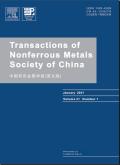7B50铝合金两阶段蠕变时效过程的本构模型及其在回弹预测中的应用
IF 4.7
1区 材料科学
Q1 METALLURGY & METALLURGICAL ENGINEERING
Transactions of Nonferrous Metals Society of China
Pub Date : 2025-03-01
DOI:10.1016/S1003-6326(24)66711-7
引用次数: 0
摘要
建立了一种新的统一本构模型来预测Al−Zn−Mg−Cu合金的两阶段蠕变时效行为。通过考虑主要微变量在不同温度下的演化及其相互作用,分析和模拟了特殊的双峰降水特征。为了捕捉蠕变变形对析出的影响,在模型中加入了位错密度。利用定量透射电子显微镜和先前研究中获得的实验数据来校准模型。随后,将所建立的本构模型通过用户子程序在有限元软件ABAQUS中实现,用于整体板的TSCA过程仿真和回弹预测。进行TSCA测试。结果表明,成形板与仿真结果的最大半径偏差小于0.4 mm,验证了所建立的本构模型和有限元模型的有效性。本文章由计算机程序翻译,如有差异,请以英文原文为准。
A novel constitutive model for two-stage creep aging process of 7B50 aluminum alloy and its application in springback prediction
A new unified constitutive model was developed to predict the two-stage creep-aging (TSCA) behavior of Al−Zn−Mg−Cu alloys. The particular bimodal precipitation feature was analyzed and modeled by considering the primary micro-variables evolution at different temperatures and their interaction. The dislocation density was incorporated into the model to capture the effect of creep deformation on precipitation. Quantitative transmission electron microscopy and experimental data obtained from a previous study were used to calibrate the model. Subsequently, the developed constitutive model was implemented in the finite element (FE) software ABAQUS via the user subroutines for TSCA process simulation and the springback prediction of an integral panel. A TSCA test was performed. The result shows that the maximum radius deviation between the formed plate and the simulation results is less than 0.4 mm, thus validating the effectiveness of the developed constitutive model and FE model.
求助全文
通过发布文献求助,成功后即可免费获取论文全文。
去求助
来源期刊
CiteScore
7.40
自引率
17.80%
发文量
8456
审稿时长
3.6 months
期刊介绍:
The Transactions of Nonferrous Metals Society of China (Trans. Nonferrous Met. Soc. China), founded in 1991 and sponsored by The Nonferrous Metals Society of China, is published monthly now and mainly contains reports of original research which reflect the new progresses in the field of nonferrous metals science and technology, including mineral processing, extraction metallurgy, metallic materials and heat treatments, metal working, physical metallurgy, powder metallurgy, with the emphasis on fundamental science. It is the unique preeminent publication in English for scientists, engineers, under/post-graduates on the field of nonferrous metals industry. This journal is covered by many famous abstract/index systems and databases such as SCI Expanded, Ei Compendex Plus, INSPEC, CA, METADEX, AJ and JICST.

 求助内容:
求助内容: 应助结果提醒方式:
应助结果提醒方式:


